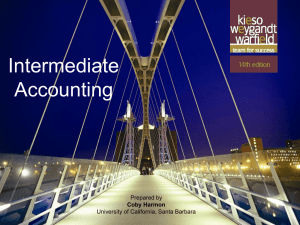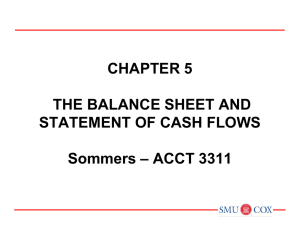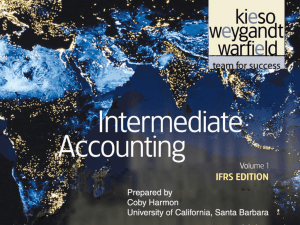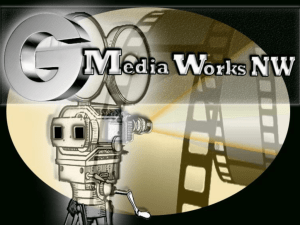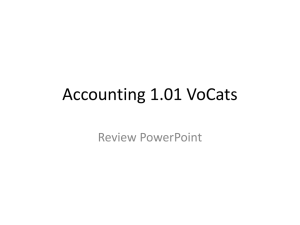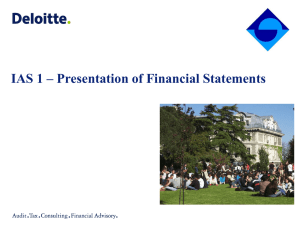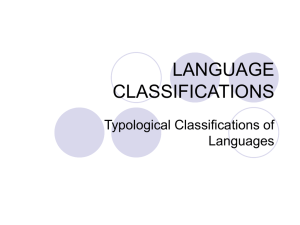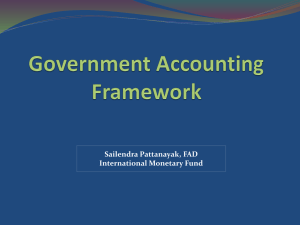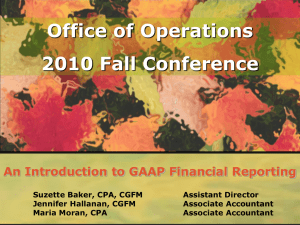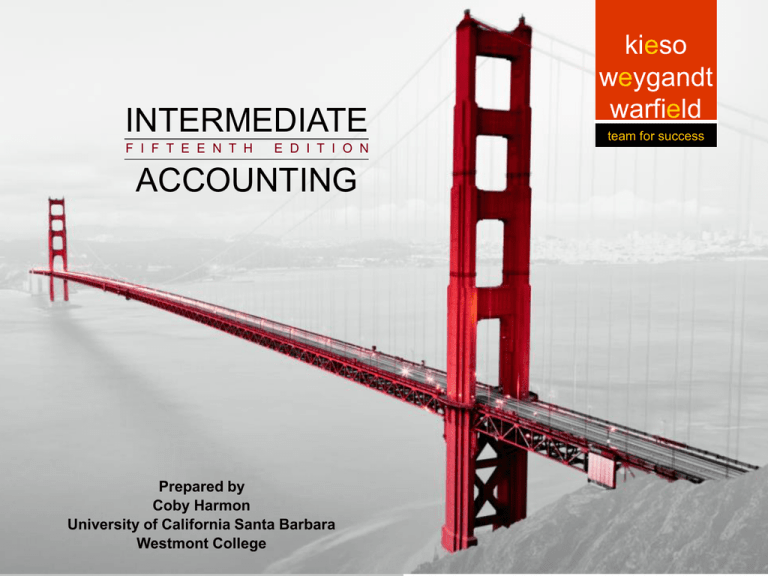
INTERMEDIATE
F I F T E E N T H
E D I T I O N
Intermediate
ACCOUNTING
Intermediate
Accounting
Accounting
5-1
Prepared
by
Prepared
by
Coby Harmon
Prepared by
Coby Harmon
Harmon
University
of California
Santa Barbara
University
of California,
Santa Coby
Barbara
University of California, Santa Barbara
Westmont
College
Westmont
College
kieso
weygandt
warfield
team for success
PREVIEW OF CHAPTER
5
Intermediate Accounting
15th Edition
Kieso Weygandt Warfield
5-2
5
Balance Sheet and
Statement of Cash Flows
LEARNING OBJECTIVES
After studying this chapter, you should be able to:
1.
2.
5-3
Explain the uses and limitations of a
balance sheet.
Identify the major classifications of the
balance sheet.
3.
Prepare a classified balance sheet using
the report and account formats.
4.
Indicate the purpose of the statement of
cash flows.
5.
Identify the content of the statement of
cash flows
6.
Prepare a basic statement of cash flows.
7.
Understand the usefulness of the
statement of cash flows.
8.
Determine which balance sheet
information requires supplemental
disclosure.
9.
Describe the major disclosure techniques
for the balance sheet.
Balance Sheet
Balance Sheet, sometimes referred to as the statement of
financial position:
1. Reports assets, liabilities, and equity at a specific date.
2. Provides information about resources, obligations to
creditors, and equity in net resources.
3. Helps in predicting amounts, timing, and uncertainty of
future cash flows.
5-4
LO 1 Explain the uses and limitations of a balance sheet.
Balance Sheet
Usefulness of the Balance Sheet
5-5
Computing rates of return.
Evaluating the capital structure.
Assess risk and future cash flows.
Analyze the company’s:
►
Liquidity,
►
Solvency, and
►
Financial flexibility.
LO 1 Explain the uses and limitations of a balance sheet.
GROUNDED
WHAT’S
YOUR PRINCIPLE
The terrorist attacks of September 11, 2001,
showed how vulnerable the major airlines are
to falling demand for their services. Since that
infamous date, major airlines have reduced
capacity and slashed jobs to avoid
bankruptcy. United Airlines, Northwest Airlines,
US Airways, and several smaller competitors fi
led for bankruptcy in the wake of 9/11. Delta
Airlines made the following statements in its
annual report issued shortly after 9/11:
“If we are unsuccessful in further reducing
our operating costs . . . we will need to
restructure our costs under Chapter 11 of
the U.S. Bankruptcy Code. . . . We have
substantial liquidity needs and there is no
assurance that we will be able to obtain the
necessary financing to meet those needs on
acceptable terms, if at all.”
5-6
These financial flexibility challenges have
continued, exacerbated by ever-increasing
fuel prices, labor costs, and the economic
downturn in response to the financial crisis.
Not surprisingly, several of the major airlines
(Delta and
Northwest, Continental and United, and
Airtran and Southwest) merged recently as a
way to build some competitive synergies and
to bolster their financial flexibility. Others
(American Airlines and US Airways) are
exploring mergers.
Source: R. Seaney, “Airline Mergers: Good for
Travelers?” http://
abcnews.go.com/Travel/airline-merger-maniacost/story?id516227892 (April 27, 2012).
LO 1 Explain the uses and limitations of a balance sheet.
Balance Sheet
Limitations of the Balance Sheet
5-7
Most assets and liabilities are reported at historical
cost.
Use of judgments and estimates.
Many items of financial value
are omitted.
LO 1 Explain the uses and limitations of a balance sheet.
5
Balance Sheet and
Statement of Cash Flows
LEARNING OBJECTIVES
After studying this chapter, you should be able to:
1.
2.
5-8
Explain the uses and limitations of a
balance sheet.
Identify the major classifications of the
balance sheet.
3.
Prepare a classified balance sheet using
the report and account formats.
4.
Indicate the purpose of the statement of
cash flows.
5.
Identify the content of the statement of
cash flows
6.
Prepare a basic statement of cash flows.
7.
Understand the usefulness of the
statement of cash flows.
8.
Determine which balance sheet
information requires supplemental
disclosure.
9.
Describe the major disclosure techniques
for the balance sheet.
Balance Sheet
Classification in the Balance Sheet
5-9
LO 2 Identify the major classifications of the balance sheet.
Balance Sheet
Classification in the Balance Sheet
Illustration 5-1
In practice you usually see little departure from these major subdivisions.
5-10
LO 2 Identify the major classifications of the balance sheet.
Classification in the Balance Sheet
Current Assets
Cash and other assets a company expects to convert into
cash, sell, or consume either in one year or in the
operating cycle, whichever is longer.
Illustration 5-2
5-11
LO 2 Identify the major classifications of the balance sheet.
Classification in the Balance Sheet
Question
The correct order to present current assets is
a. Cash, accounts receivable, prepaid items, inventories.
b. Cash, accounts receivable, inventories, prepaid items.
c. Cash, inventories, accounts receivable, prepaid items.
d. Cash, inventories, prepaid items, accounts receivable.
Order of Liquidity
5-12
LO 2 Identify the major classifications of the balance sheet.
Balance Sheet – “Current Assets”
Cash
Generally any monies available “on demand.”
Cash equivalents - short-term highly liquid investments
that mature within three months or less.
Restrictions or commitments must be disclosed.
Illustration 5-3
Balance Sheet—Restricted Cash
5-13
LO 2
Balance Sheet – “Current Assets”
Cash
Illustration 5-4
Balance Sheet—Restricted Cash
5-14
LO 2 Identify the major classifications of the balance sheet.
Balance Sheet – “Current Assets”
Short-Term Investments
5-15
Portfolios
Type
Valuation
Classification
Held-toMaturity
Debt
Amortized
Cost
Current or
Noncurrent
Trading
Debt or
Equity
Fair Value
Current
Availablefor-Sale
Debt or
Equity
Fair Value
Current or
Noncurrent
LO 2 Identify the major classifications of the balance sheet.
Balance Sheet – “Current Assets”
Short-Term Investments
Illustration 5-5
Balance Sheet Presentation of
Investments in Securities
5-16
LO 2 Identify the major classifications of the balance sheet.
Balance Sheet – “Current Assets”
Receivables
Major categories of receivables should be shown in the
balance sheet or the related notes.
A company should clearly identify
5-17
Anticipated loss due to uncollectibles.
Amount and nature of any nontrade receivables.
Receivables used as collateral.
LO 2 Identify the major classifications of the balance sheet.
Balance Sheet – “Current Assets”
Receivables
Illustration 5-6
Balance Sheet Presentation
of Receivables
5-18
LO 2
Balance Sheet – “Current Assets”
Inventories
Disclose:
►
Basis of valuation (e.g., lower-of-cost-or-market).
►
Cost flow assumption (e.g., FIFO or LIFO).
Illustration 5-7
Balance Sheet Presentation of Inventories
5-19
LO 2
Balance Sheet – “Current Assets”
Prepaid Expenses
Payment of cash, that is recorded as an asset because
service or benefit will be received in the future.
Cash Payment
Expense Recorded
BEFORE
Prepayments often occur in regard to:
5-20
insurance
rent
supplies
taxes
advertising
LO 2 Identify the major classifications of the balance sheet.
Balance Sheet – “Current Assets”
Prepaid Expenses
Illustration 5-9
Balance Sheet Presentation
of Prepaid Expenses
5-21
LO 2 Identify the major classifications of the balance sheet.
Balance Sheet – “Current Assets”
Summary
Balance Sheet (in thousands)
Cash and other assets
a company expects to
convert into cash,
sell, or
consume
Cash
$ 285,000
ST Investments
140,000
Accounts receivable
777,000
Inventory
402,000
Prepaid expenses
170,000
Total current assets
1,774,000
Investments:
either in one year or in
the operating cycle,
whichever is longer.
5-22
Current assets
Invesment in ABC bonds
321,657
Investment in UC Inc.
253,980
LO 2 Identify the major classifications of the balance sheet.
Classification in the Balance Sheet
Noncurrent Assets
Long-term Investments
1. Securities (bonds, common stock, or long-term notes).
2. Tangible fixed assets not currently used in operations
(land held for speculation).
3. Special funds (sinking fund, pension fund, plant expansion
fund, or cash surrender value of life insurance).
4. Nonconsolidated subsidiaries or affiliated companies.
5-23
LO 2 Identify the major classifications of the balance sheet.
Balance Sheet – “Noncurrent Assets”
Long-Term Investments
5-24
Portfolios
Type
Valuation
Classification
Held-toMaturity
Debt
Amortized
Cost
Current or
Noncurrent
Trading
Debt or
Equity
Fair Value
Current
Availablefor-Sale
Debt or
Equity
Fair Value
Current or
Noncurrent
LO 2 Identify the major classifications of the balance sheet.
Balance Sheet – “Noncurrent Assets”
Balance Sheet (in thousands)
Long-Term
Investments
Current assets
Cash
$ 285,000
Investments:
Securities
Invesment in ABC bonds
321,657
Investment in UC Inc.
253,980
Notes receivable
150,000
Bonds,
Stock, and
Land held for speculation
550,000
Long-term notes
Sinking fund
225,000
Pension fund
653,798
For marketable securities,
management’s intent
determines current or
noncurrent classification.
Cash surrender value
Investment in Uncon. Sub.
Total investments
LO 2
457,836
2,696,592
Property, Plant, and Equip.
Building
5-25
84,321
Land
1,375,778
975,000
Balance Sheet – “Noncurrent Assets”
Balance Sheet (in thousands)
Long-Term
Investments
Current assets
Cash
$ 285,000
Investments:
Fixed Assets
Land held for
speculation
Invesment in ABC bonds
321,657
Investment in UC Inc.
253,980
Notes receivable
150,000
Land held for speculation
550,000
Sinking fund
225,000
Pension fund
653,798
Cash surrender value
Investment in Uncon. Sub.
Total investments
84,321
457,836
2,696,592
Property, Plant, and Equip.
Building
5-26
LO 2
Land
1,375,778
975,000
Balance Sheet – “Noncurrent Assets”
Balance Sheet (in thousands)
Long-Term
Investments
Current assets
Cash
$ 285,000
Investments:
Special Funds
Invesment in ABC bonds
321,657
Investment in UC Inc.
253,980
Notes receivable
150,000
Sinking fund
Pensions fund
Land held for speculation
550,000
Cash surrender
value of life
insurance
Sinking fund
225,000
Pension fund
653,798
Cash surrender value
Investment in Uncon. Sub.
Total investments
84,321
457,836
2,696,592
Property, Plant, and Equip.
Building
5-27
LO 2
Land
1,375,778
975,000
Balance Sheet – “Noncurrent Assets”
Balance Sheet (in thousands)
Long-Term
Investments
Current assets
Cash
$ 285,000
Investments:
Nonconsolidated
Subsidiaries or
Affiliated
Companies
Invesment in ABC bonds
321,657
Investment in UC Inc.
253,980
Notes receivable
150,000
Land held for speculation
550,000
Sinking fund
225,000
Pension fund
653,798
Cash surrender value
Investment in Uncon. Sub.
Total investments
84,321
457,836
2,696,592
Property, Plant, and Equip.
Building
5-28
LO 2
Land
1,375,778
975,000
Balance Sheet – “Noncurrent Assets”
Long-Term Investments
Illustration 5-10
Balance Sheet
Presentation of
Long-Term Investments
5-29
LO 2 Identify the major classifications of the balance sheet.
Balance Sheet – “Noncurrent Assets”
Property, Plant, and Equipment
Tangible long-lived assets used in the regular operations
of the business.
Physical property such as land, buildings, machinery,
furniture, tools, and wasting resources (minerals).
With the exception of land, a company either depreciates
(e.g., buildings) or depletes (e.g., oil reserves) these
assets.
5-30
LO 2 Identify the major classifications of the balance sheet.
Balance Sheet – “Noncurrent Assets”
Balance Sheet (in thousands)
Property, Plant, and
Equipment
A company discloses the
basis it uses to value
property, plant, and
equipment.
5-31
Current assets
Cash
Total investments
Property, Plant, and Equip.
Building
Land
Machinery and equipment
Capital leases
Leasehold improvements
Accumulated depreciation
Total PP&E
Intangibles
Goodwill
Patents
Trademarks
$ 285,000
2,696,592
1,375,778
975,000
234,958
384,650
175,000
(975,000)
2,170,386
3,000,000
177,000
40,000
LO 2 Identify the major classifications of the balance sheet.
Balance Sheet – “Noncurrent Assets”
Property, Plant, and Equipment
Illustration 5-11
Balance Sheet Presentation of
Property, Plant, and Equipment
5-32
LO 2 Identify the major classifications of the balance sheet.
Balance Sheet – “Noncurrent Assets”
Balance Sheet (in thousands)
Intangible Assets
Lack physical substance
and are not financial
instruments.
5-33
Limited life intangibles
amortized.
Indefinite-life
intangibles tested for
impairment.
Current assets
Cash
Total PP&E
Intangibles
Goodwill
Patents
Trademark
Franchises
Copyright
Total intangibles
Other assets
Prepaid pension costs
Deferred income tax
Total other
Total Assets
$ 285,000
2,170,386
2,000,000
177,000
40,000
125,000
55,000
2,397,000
133,000
40,000
173,000
$ 9,210,978
LO 2
Balance Sheet – “Noncurrent Assets”
Illustration: Patrick Corporation adjusted trial balance contained the
following asset accounts at December 31, 2014: Prepaid Rent
$12,000; Goodwill $50,000; Franchise Fees Receivable $2,000;
Franchises $47,000; Patents $33,000; Trademarks $10,000. Prepare
the intangible assets section of the balance sheet.
Intangible Assets
Goodwill
Franchises
47,000
Patents
33,000
Trademarks
10,000
Total
5-34
$ 50,000
$140,000
LO 2 Identify the major classifications of the balance sheet.
Balance Sheet – “Noncurrent Assets”
Intangible Assets
Illustration 5-12
Balance Sheet
Presentation of
Intangible Assets
5-35
LO 2 Identify the major classifications of the balance sheet.
Balance Sheet – “Noncurrent Assets”
Other Assets
Items vary in practice. Can include
5-36
Long-term prepaid expenses
Non-current receivables
Assets in special funds
Deferred income taxes
Property held for sale
Restricted cash or securities
LO 2 Identify the major classifications of the balance sheet.
Balance Sheet – “Noncurrent Assets”
Balance Sheet (in thousands)
Other Assets
This section should
include only unusual items
sufficiently different from
assets in the other
categories.
5-37
Current assets
Cash
Total PP&E
Intangibles
Goodwill
Patents
Trademark
Franchises
Copyright
Total intangibles
Other assets
Prepaid pension costs
Deferred income tax
Total other
Total Assets
$ 285,000
2,170,386
2,000,000
177,000
40,000
125,000
55,000
2,397,000
133,000
40,000
173,000
$ 9,210,978
LO 2
Classification in the Balance Sheet
Liabilities
Balance Sheet (in thousands)
Companies classify
liabilities as current or
long-term.
5-38
Current liabilities
Notes payable
Accounts payable
Accrued compensation
Unearned revenue
Income tax payable
Current maturities LT debt
Total current liabilities
Long-term liabilities
Long-term debt
Obligations capital lease
Deferred income taxes
Total long-term liabilities
Stockholders' equity
$ 233,450
131,800
43,000
17,000
23,400
121,000
569,650
979,500
345,800
77,909
1,403,209
LO 2 Identify the major classifications of the balance sheet.
Balance Sheet – “Liabilities”
Current Liabilities
Obligations that a
company reasonably
expects to liquidate either
through the use of
current assets or the
creation of other current
liabilities.
5-39
Balance Sheet (in thousands)
Current liabilities
Notes payable
Accounts payable
Accrued compensation
Unearned revenue
Income tax payable
Current maturities LT debt
Total current liabilities
Long-term liabilities
Long-term debt
Obligations capital lease
Deferred income taxes
Total long-term liabilities
Stockholders' equity
$ 233,450
131,800
43,000
17,000
23,400
121,000
569,650
979,500
345,800
77,909
1,403,209
LO 2 Identify the major classifications of the balance sheet.
Balance Sheet – “Liabilities”
Current Liabilities
Illustration 5-13
Balance Sheet Presentation
of Current Liabilities
5-40
LO 2 Identify the major classifications of the balance sheet.
Balance Sheet – “Liabilities”
Long-Term Liabilities
Obligations that a
company does not
reasonably expect to
liquidate within the normal
operating cycle.
All covenants and
restrictions must be
disclosed.
5-41
Balance Sheet (in thousands)
Current liabilities
Notes payable
Accounts payable
Accrued compensation
Unearned revenue
Income tax payable
Current maturities LT debt
Total current liabilities
Long-term liabilities
Long-term debt
Obligations capital lease
Deferred income taxes
Total long-term liabilities
Stockholders' equity
$ 233,450
131,800
43,000
17,000
23,400
121,000
569,650
979,500
345,800
77,909
1,403,209
LO 2 Identify the major classifications of the balance sheet.
“SHOW ME
THE ASSETS!”
WHAT’S
YOUR
PRINCIPLE
Before the dot-com bubble burst, concerns about
liquidity and solvency led creditors of many dotcom companies to demand more assurances that
these companies could pay their bills when due. A
key indicator for creditors is the Some vendors
demanded that their dot-com customers sign
notes stating that the goods shipped to them
would serve as collateral for the transaction.
Other vendors began shipping goods on
consignment—an arrangement whereby the
vendor retains ownership of the goods until a third
party buys and pays for them. Another recent
bubble in the real estate market created a working
capital and liquidity crisis for no less a revered
financial institution than Bear Stearns. What
happened? Bear Stearns was one of the biggest
investors in mortgage backed securities. But
when the housing market cooled off and the value
of the collateral backing Bear Stearns’s mortgage
5-42
amount of working capital. For example, when a
report predicted that Amazon.com’s working
capital would turn negative, the company’s
vendors began to explore steps that would ensure
that Amazon would pay them. securities dropped
dramatically, the market began to question
Bear Stearns’s ability to meet its obligations. The
result: The Federal Reserve stepped in to avert a
collapse of the company, backing a bailout plan
that guaranteed $30 billion of Bear Stearns’s
investments. This paved the way for a buy-out by
JPMorgan Chase at $2 per share (later amended
to $10 a share)—quite a bargain since Bear
Stearns had been trading above $80 a share just
a month earlier.
Source: Robin Sidel, Greg Ip, Michael M. Phillips,
and Kate Kelly, “The Week That Shook Wall
Street: Inside the Demise of Bear Stearns,” Wall
Street Journal (March 18, 2008), p. A1.
LO 2 Identify the major classifications of the balance sheet.
Balance Sheet – “Liabilities”
Illustration: Included in Adams Company’s December 31, 2014, trial
balance are the following accounts: Accounts Payable $220,000;
Pension Asset/Liability $375,000; Discount on Bonds Payable
$29,000; Unearned Revenue $41,000; Bonds Payable $400,000;
Salaries and Wages Payable $27,000; Interest Payable $12,000;
Income Taxes Payable $29,000. Prepare the long-term liabilities
section of the balance sheet.
Long-term liabilities
Pension Asset/liability
Bonds payable
Discount on bonds payable
Total
5-43
$375,000
400,000
(29,000)
$746,000
LO 2 Identify the major classifications of the balance sheet.
Balance Sheet – “Liabilities”
Long-Term Liabilities
Illustration 5-14
Balance Sheet Presentation
of Long-Term Liabilities
5-44
LO 2
Classification in the Balance Sheet
Owners’ Equity
5-45
LO 2 Identify the major classifications of the balance sheet.
Classification in the Balance Sheet
Owners’ Equity
Illustration 5-15
Balance Sheet Presentation
of Stockholders’ Equity
5-46
LO 2 Identify the major classifications of the balance sheet.
Classification in the Balance Sheet
Account
5-47
Classification
(a) Investment in preferred stock
(a) Current asset/Investment
(b) Treasury stock
(b) Stockholders’ Equity
(c) Common stock
(c) Stockholders’ Equity
(d) Cash dividends payable
(d) Current liability
(e) Accumulated depreciation
(e) Contra-asset
(f) Interest payable
(f) Current liability
(g) Deficit
(g) Stockholders’ Equity
(h) Trading securities
(h) Current asset
(i) Unearned revenue
(i) Current liability
LO 2 Identify the major classifications of the balance sheet.
5
Balance Sheet and
Statement of Cash Flows
LEARNING OBJECTIVES
After studying this chapter, you should be able to:
1.
2.
Explain the uses and limitations of a
balance sheet.
Identify the major classifications of the
balance sheet.
3.
Prepare a classified balance sheet using
the report and account formats.
4.
Indicate the purpose of the statement of
cash flows.
5.
Identify the content of the statement of
cash flows
5-48
6.
Prepare a basic statement of cash flows.
7.
Understand the usefulness of the
statement of cash flows.
8.
Determine which balance sheet
information requires supplemental
disclosure.
9.
Describe the major disclosure techniques
for the balance sheet.
Balance Sheet Format
Classified Balance Sheet
Account form
Report form
Accounting Trends and Techniques—2011 (New York: AICPA)
indicates that all of the 500 companies surveyed use either the
“report form” (4848) or the “account form” (16), sometimes
collectively referred to as the “customary form.”
5-49
LO 3 Prepare a classified balance sheet using the report and account formats.
Balance Sheet
Format
Report Form
Illustration 5-16
5-50
LO 3
WARNINGYOUR
SIGNALS
WHAT’S
PRINCIPLE
5-51
LO 3 Prepare a classified balance sheet using the report and account formats.
5
Balance Sheet and
Statement of Cash Flows
LEARNING OBJECTIVES
After studying this chapter, you should be able to:
1.
2.
Explain the uses and limitations of a
balance sheet.
Identify the major classifications of the
balance sheet.
3.
Prepare a classified balance sheet using
the report and account formats.
4.
Indicate the purpose of the statement of
cash flows.
5.
Identify the content of the statement of
cash flows
5-52
6.
Prepare a basic statement of cash flows.
7.
Understand the usefulness of the
statement of cash flows.
8.
Determine which balance sheet
information requires supplemental
disclosure.
9.
Describe the major disclosure techniques
for the balance sheet.
Statement of Cash Flows
The income statement, the statement of stockholders’
equity, and the balance sheet—each present SOME
information about the cash flows of an enterprise during a
period.
The statement of cash flows
presents a DETAILED
SUMMARY of all the cash
inflows and outflows, or the
sources and uses of cash
during the period.
5-53
LO 4 Indicate the purpose of the statement of cash flows.
Statement of Cash Flows
Purpose of the Statement of Cash Flows
To provide relevant information about the cash receipts
and cash payments of an enterprise during a period.
The statement provides answers to the following
questions:
1. Where did the cash come from?
2. What was the cash used for?
3. What was the change in the cash balance?
5-54
LO 4 Indicate the purpose of the statement of cash flows.
WATCH THAT
CASH
FLOW
WHAT’S
YOUR
PRINCIPLE
Investors usually focus on net income measured
on an accrual basis. However, information on
cash flows can be important for assessing a
company’s liquidity, financial flexibility, and overall
financial performance. The graph below shows W.
T. Grant’s financial performance over 7 years.
Although W. T. Grant showed consistent profits
and even some periods of earnings growth, its
cash flow began to “go
5-55
south” starting in about year 3. The company fi
led for bankruptcy shortly after year 7. Financial
statement readers who studied the company’s
cash flows would have found early warnings of its
problems. The Grant experience is a classic
case, illustrating the importance of cash flows as
an early warning signal of financial problems.
A more recent retailer case is Target. Although
Target has shown good profits, some are
concerned that a bit too much of its sales have
been made on credit rather than cash. Why is
this a problem? Like W. T. Grant, the earnings of
profitable lenders can get battered in future
periods if they have to start adding large amounts
to their bad-loan reserve to catch up with credit
losses. And if losses ramp up on Target-branded
credit cards, Target may get hit in this way.
Source: Peter Eavis, “Is Target Corp.’s Credit Too
Generous?” Wall 1 Street Journal (March 11,
2008), p. C1.
LO 4
5
Balance Sheet and
Statement of Cash Flows
LEARNING OBJECTIVES
After studying this chapter, you should be able to:
1.
2.
Explain the uses and limitations of a
balance sheet.
Identify the major classifications of the
balance sheet.
3.
Prepare a classified balance sheet using
the report and account formats.
4.
Indicate the purpose of the statement of
cash flows.
5.
Identify the content of the statement of
cash flows
5-56
6.
Prepare a basic statement of cash flows.
7.
Understand the usefulness of the
statement of cash flows.
8.
Determine which balance sheet
information requires supplemental
disclosure.
9.
Describe the major disclosure techniques
for the balance sheet.
Statement of Cash Flows
Content and Format
Three different activities:
Operating,
Investing,
Financing
Illustration 5-17
Basic Format of Cash
Flow Statement
5-57
LO 5 Identify the content of the statement of cash flows.
Statement of Cash Flows
Content and Format
5-58
Operating
Investing
Financing
Cash effects of
transactions that
enter into the
determination of net
income.
Making and
collecting loans and
acquiring and
disposing of
investments and
property, plant, and
equipment.
Obtaining
resources from
owners and
providing them with
a return on their
investment, and
borrowing money
from creditors and
repaying the
amounts borrowed.
LO 5 Identify the content of the statement of cash flows.
Statement of Cash Flows
Illustration 5-18
5-59
LO 5 Identify the content of the statement of cash flows.
5
Balance Sheet and
Statement of Cash Flows
LEARNING OBJECTIVES
After studying this chapter, you should be able to:
1.
2.
Explain the uses and limitations of a
balance sheet.
Identify the major classifications of the
balance sheet.
3.
Prepare a classified balance sheet using
the report and account formats.
4.
Indicate the purpose of the statement of
cash flows.
5.
Identify the content of the statement of
cash flows
5-60
6.
Prepare a basic statement of cash flows.
7.
Understand the usefulness of the
statement of cash flows.
8.
Determine which balance sheet
information requires supplemental
disclosure.
9.
Describe the major disclosure techniques
for the balance sheet.
Statement of Cash Flows
Overview of the Preparation of the Statement
Information obtained from several sources:
1) comparative balance sheets,
2) the current income statement, and
3) selected transaction data.
5-61
LO 6 Prepare a basic statement of cash flows.
Statement of Cash Flows
Illustration: On January 1, 2014, in its first year of
operations, Telemarketing Inc. issued 50,000 shares of $1 par
value common stock for $50,000 cash. The company rented
its office space, furniture, and telecommunications equipment
and performed marketing services throughout the first year. In
June 2014 the company purchased land for $15,000.
Illustration 5-19 shows the company’s comparative balance
sheets at the beginning and end of 2014.
5-62
LO 6 Prepare a basic statement of cash flows.
Statement of Cash Flows
Illustration 5-19
Illustration 5-20
5-63
LO 6
Statement of Cash Flows
Preparing the Statement of Cash Flows
Four steps:
1. Determine the net cash provided by (or used in) operating
activities.
2. Determine the net cash provided by (or used in) investing and
financing activities.
3. Determine the change (increase or decrease) in cash during
the period.
4. Reconcile the change in cash with the beginning and the
ending cash balances.
5-64
LO 6 Prepare a basic statement of cash flows.
Statement of Cash Flows
Illustration 5-19
Illustration 5-20
Cash provided by operating activities
5-65
Advance slide in presentation
mode to reveal answers.
Illustration 5-21
LO 6 Prepare a basic statement of cash flows.
Illustration 5-19
Illustration 5-20
Statement of
Cash Flows
Next, the company
determines its investing
and financing activities.
5-66
Advance slide in
presentation
mode to reveal
answers.
Illustration 5-22
Statement of Cash Flows
Illustration: Keyser Beverage Company reported the following
items in the most recent year.
Activity
5,000
Operating
Financing
10,000
7,000
Operating
Operating
Purchase of equipment
Depreciation expense
8,000
4,000
Investing
Operating
Issue of notes payable
20,000
Financing
Net income
Dividends paid
Increase in accounts receivable
Increase in accounts payable
$40,000
Required: Compute net cash provided by operating activities.
5-67
Advance slide in
presentation mode to
reveal answers.
LO 6 Prepare a basic statement of cash flows.
Statement of Cash Flows
Statement of Cash Flow (in thousands)
Operating activities
Net income
Increase in accounts receivable
Increase in accounts payable
Depreciation expense
Cash flow from operations
Investing activities
Purchase of equipment
Financing activities
Proceeds from notes payable
Dividends paid
Cash flow from financing
Increase in cash
5-68
$ 40,000
(10,000)
5,000
40,000
75,000
Noncash credit to
revenues.
Noncash charge to
expenses.
(8,000)
20,000
(5,000)
15,000
$ 82,000
LO 6 Prepare a basic statement of cash flows.
Statement of Cash Flows
Question
In preparing a statement of cash flows, which of the following
transactions would be considered an investing activity?
5-69
a.
Sale of equipment at book value
b.
Sale of merchandise on credit
c.
Declaration of a cash dividend
d.
Issuance of bonds payable at a discount receivable.
LO 6 Prepare a basic statement of cash flows.
Statement of Cash Flows
Significant Noncash Activities
Significant financing and investing activities that do not
affect cash are reported in either a separate schedule at
the bottom of the statement of cash flows or in the notes.
Examples include:
5-70
Issuance of common stock to purchase assets.
Conversion of bonds into common stock.
Issuance of debt to purchase assets.
Exchanges on long-lived assets.
LO 6 Prepare a basic statement of cash flows.
Statement of Cash Flows
Illustration 5-23
Comprehensive
Statement of Cash Flows
5-71
5
Balance Sheet and
Statement of Cash Flows
LEARNING OBJECTIVES
After studying this chapter, you should be able to:
1.
2.
Explain the uses and limitations of a
balance sheet.
Identify the major classifications of the
balance sheet.
3.
Prepare a classified balance sheet using
the report and account formats.
4.
Indicate the purpose of the statement of
cash flows.
5.
Identify the content of the statement of
cash flows
5-72
6.
Prepare a basic statement of cash flows.
7.
Understand the usefulness of the
statement of cash flows.
8.
Determine which balance sheet
information requires supplemental
disclosure.
9.
Describe the major disclosure techniques
for the balance sheet.
Statement of Cash Flows
Usefulness of the Statement of Cash Flows
Without cash, a company will not survive.
Cash flow from Operations:
5-73
High amount - company able to generate sufficient cash
to pay its bills.
Low amount - company may have to borrow or issue
equity securities to pay bills.
LO 7 Understand the usefulness of the statement of cash flows.
Usefulness of the Statement of Cash Flows
Financial Liquidity
Illustration 5-25
Current Cash
Debt Coverage =
Ratio
Net Cash Provided by
Operating Activities
Average Current Liabilities
Ratio indicates whether the company can pay off its current
liabilities from internally generated cash flows. A ratio near 1:1 is
good.
5-74
LO 7 Understand the usefulness of the statement of cash flows.
Usefulness of the Statement of Cash Flows
Financial Flexibility
Illustration 5-26
Cash Debt
Coverage
Ratio
Net Cash Provided by
Operating Activities
=
Average Total Liabilities
This ratio indicates a company’s ability to repay its liabilities from
net cash provided by operating activities, without having to
liquidate the assets employed in its operations.
5-75
LO 7 Understand the usefulness of the statement of cash flows.
Usefulness of the Statement of Cash Flows
Free Cash Flow
Illustration 5-28
The amount of discretionary cash flow a company has that may
be used for purchasing additional investments, retiring its debt,
purchasing treasury stock, or simply adding to its liquidity.
5-76
LO 7 Understand the usefulness of the statement of cash flows.
Usefulness of the Statement of Cash Flows
Question
The current cash debt coverage ratio is often used to assess
a. financial flexibility.
b. liquidity.
c. profitability.
d. solvency.
5-77
LO 7 Understand the usefulness of the statement of cash flows.
5
Balance Sheet and
Statement of Cash Flows
LEARNING OBJECTIVES
After studying this chapter, you should be able to:
1.
2.
Explain the uses and limitations of a
balance sheet.
Identify the major classifications of the
balance sheet.
3.
Prepare a classified balance sheet using
the report and account formats.
4.
Indicate the purpose of the statement of
cash flows.
5.
Identify the content of the statement of
cash flows
5-78
6.
Prepare a basic statement of cash flows.
7.
Understand the usefulness of the
statement of cash flows.
8.
Determine which balance sheet
information requires supplemental
disclosure.
9.
Describe the major disclosure techniques
for the balance sheet.
Additional Information
Supplemental Disclosures
Four types of information that are supplemental to account
titles and amounts presented in the balance sheet:
5-79
LO 8 Determine which balance sheet information
requires supplemental disclosure.
5
Balance Sheet and
Statement of Cash Flows
LEARNING OBJECTIVES
After studying this chapter, you should be able to:
1.
2.
Explain the uses and limitations of a
balance sheet.
Identify the major classifications of the
balance sheet.
3.
Prepare a classified balance sheet using
the report and account formats.
4.
Indicate the purpose of the statement of
cash flows.
5.
Identify the content of the statement of
cash flows
5-80
6.
Prepare a basic statement of cash flows.
7.
Understand the usefulness of the
statement of cash flows.
8.
Determine which balance sheet
information requires supplemental
disclosure.
9.
Describe the major disclosure techniques
for the balance sheet.
Additional Information
Techniques of Disclosure
5-81
Parenthetical Explanations
Notes
Cross-Reference and Contra Items
Supporting Schedules
Terminology
LO 9 Describe the major disclosure techniques for the balance sheet.
APPENDIX
5A
Ratio Analysis—A Reference
Using Ratios to Analyze Performance
Analysts and other interested parties can gather qualitative
information from financial statements by examining relationships
between items on the statements and identifying trends in these
relationships.
5-82
LO 10 Identify the major types of financial ratios and what they measure.
APPENDIX
5A
Using Ratios
5-83
Ratio Analysis—A Reference
Illustration 5A-1
A Summary of Financial Ratios
LO 10 Identify the major types of financial ratios and what they measure.
APPENDIX
5A
Using Ratios
5-84
Ratio Analysis—A Reference
Illustration 5A-1
A Summary of Financial Ratios
LO 10 Identify the major types of financial ratios and what they measure.
APPENDIX
5A
Using Ratios
5-85
Ratio Analysis—A Reference
Illustration 5A-1
A Summary of Financial Ratios
LO 10 Identify the major types of financial ratios and what they measure.
APPENDIX
5B
Specimen Financial Statements:
The Procter & Gamble Company
The following are the traditional financial portions of the annual
report:
• Letter to the Stockholders
• Financial Highlights
• Management’s Discussion and Analysis
• Management Certification of Financial Statements
• Management’s Report on Internal Control
• Auditor’s Reports
• Financial Statements
• Notes to the Financial Statements
• Supplementary Financial Information (e.g., 10-year financial
summary)
5-86
APPENDIX
5B
Specimen Financial Statements:
The Procter & Gamble Company
Consolidated Statement of Earnings
5-87
APPENDIX
5B
Specimen Financial Statements:
The Procter & Gamble Company
Consolidated Balance Sheets
5-88
APPENDIX
5B
Specimen Financial Statements:
The Procter & Gamble Company
Consolidated Balance Sheets
5-89
APPENDIX
5B
Specimen Financial Statements:
The Procter & Gamble Company
Consolidated Statement of Shareholders’ Equity
Dollars in millions/Shares in thousands
Statements for the year ended 2010 and 2009 not presented.
5-90
APPENDIX
5B
Specimen Financial Statements:
The Procter & Gamble Company
Consolidated Statement of Cash Flows
5-91
RELEVANT FACTS - Similarities
5-92
Both IFRS and GAAP allow the use of title “balance sheet” or “statement
of financial position.” IFRS recommends but does not require the use of
the title “statement of financial position” rather than balance sheet.
Both IFRS and GAAP require disclosures about (1) accounting policies
followed, (2) judgments that management has made in the process of
applying the entity’s accounting policies, and (3) the key assumptions
and estimation uncertainty that could result in a material adjustment to
the carrying amounts of assets and liabilities within the next financial
year. Comparative prior period information must be presented and
financial statements must be prepared annually.
IFRS and GAAP require presentation of noncontrolling interests in the
equity section of the balance sheet.
LO 11 Compare the accounting procedure related to the
balance sheet under GAAP and IFRS.
RELEVANT FACTS - Differences
5-93
IFRS requires a classified statement of financial position except in very
limited situations. IFRS follows the same guidelines as this textbook for
distinguishing between current and noncurrent assets and liabilities.
However under GAAP, public companies must follow SEC regulations,
which require specific line items.
Under IFRS, current assets are usually listed in the reverse order of
liquidity. For example, under GAAP cash is listed first, but under IFRS it
is listed last.
IFRS has many differences in terminology. For example in the equity
section common stock is called share capital—ordinary.
Use of the term “reserve” is discouraged in GAAP, but there is no such
prohibition in IFRS.
LO 11 Compare the accounting procedure related to the
balance sheet under GAAP and IFRS.
ON THE HORIZON
The FASB and the IASB are working on a project to converge their standards
related to financial statement presentation. A key feature of the proposed
framework is that each of the statements will be organized, in the same format,
to separate an entity’s financing activities from its operating and investing
activities and, further, to separate financing activities into transactions with
owners and creditors. Thus, the same classifications used in the statement of
financial position would also be used in the statement of comprehensive
income and the statement of cash flows. The project has three phases. You
can follow the joint financial presentation project at the following link:
http://www.fasb.org/project/financial_statement_ presentation.shtml.
5-94
LO 11 Compare the accounting procedure related to the
balance sheet under GAAP and IFRS.
IFRS SELF-TEST QUESTION
Current assets under IFRS are listed generally:
a. by importance.
b. in the reverse order of their expected conversion to cash.
c.
by longevity.
d. alphabetically.
5-95
LO 11 Compare the accounting procedure related to the
balance sheet under GAAP and IFRS.
IFRS SELF-TEST QUESTION
Companies that use IFRS:
a. may report all their assets on the statement of financial position
at fair value.
b. are not allowed to net assets (assets 2 liabilities) on their
statement of financial positions.
c.
may report noncurrent assets before current assets on the
statement of financial position.
d. do not have any guidelines as to what should be reported on the
statement of financial position.
5-96
LO 11 Compare the accounting procedure related to the
balance sheet under GAAP and IFRS.
IFRS SELF-TEST QUESTION
A company has purchased a tract of land and expects to build a
production plant on the land in approximately 5 years. During the 5
years before construction, the land will be idle. Under IFRS, the land
should be reported as:
a. land expense.
b. property, plant, and equipment.
c.
an intangible asset.
d. a long-term investment.
5-97
LO 11 Compare the accounting procedure related to the
balance sheet under GAAP and IFRS.
Copyright
Copyright © 2013 John Wiley & Sons, Inc. All rights reserved.
Reproduction or translation of this work beyond that permitted in
Section 117 of the 1976 United States Copyright Act without the
express written permission of the copyright owner is unlawful.
Request for further information should be addressed to the
Permissions Department, John Wiley & Sons, Inc. The purchaser
may make back-up copies for his/her own use only and not for
distribution or resale. The Publisher assumes no responsibility for
errors, omissions, or damages, caused by the use of these
programs or from the use of the information contained herein.
5-98

